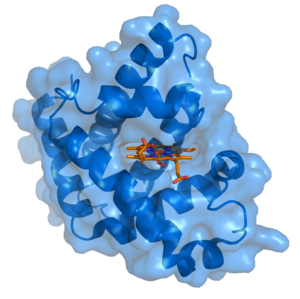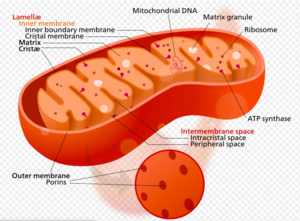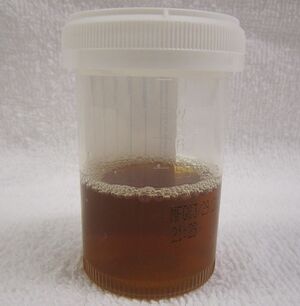Myoglobin
Original Editor - Lucinda hampton
Top Contributors - Lucinda hampton
Introduction[edit | edit source]
Myoglobin (Hb) is an iron-containing heme protein that is present predominantly in the sarcoplasm of skeletal and cardiac muscles. Due to the presence of heme moiety, myoglobin serves as a carrier and store for oxygen in muscle cells of the body. Myoglobin has more affinity for oxygen as compared to hemoglobin. As a result, it can acquire oxygen from hemoglobin, hence transferring it from the blood to the muscle tissues.[1]
IMAGE 1: Cartoon representation of Myoglobin (blue) with heme group (orange)
Here is the basic information Mb.
- It is a low molecular weight oxygen-binding heme protein and is one of the most important proteins in the human body.
- Mb is synthesized inside muscle cells. It "stores" oxygen there for use at times of high metabolic demand.
- It is mainly found in the heart and skeletal muscle cells, occurring in the highest concentration in the striated muscles of vertebrates.
- In skeletal muscle it serves to transport oxygen from the cell membrane to the mitochondria.
- Diving mammals such as seals and whales are able to remain submerged for long periods because they have greater amounts of myoglobin in their muscles than other animals do[2].
The effect of endurance training on myoglobin concentrations[edit | edit source]
Aerobic workouts/endurance training trigger important metabolic changes in muscle tissue, including an increase in mitochondria and the protein myoglobin. Mitochondria (the powerhouses of the cells) are necessary for creating ATP for energy. Myoglobin, on the other hand brings in the oxygen needed for that process. These changes improve the aerobic capacity of muscles. ie Endurance exercise can increase the amount of myoglobin in a cell, as increased aerobic respiration increases the need for oxygen[3].
Pathophysiology[edit | edit source]
Myoglobinuria occurs due to excess myoglobin in the blood resulting from the damage to the cell membrane of myocytes. It can be caused by a direct injury that damages the cells. The intracellular contents, including myoglobin, enters the bloodstream. Alternatively, this damage to the cell membrane can be a result of metabolic disturbances.
IMAGE 3: Urine from a person with rhabdomyolysis showing the characteristic brown discoloration as a result of myoglobinuria
The classic history of myoglobinuria points towards rhabdomyolysis and includes the triad of weakness, muscular pain, and dark urine.
- Acute kidney injury is the most common complication of myoglobinuria.
- The other most common complication is electrolyte disturbance, especially hyperkalemia due to the spillage of intracellular contents from the damaged myocytes.
If it has occurred due to rigorous exercise, the patients should be educated to modify their exercise routine and intensity. They should also be advised to maintain proper hydration during their activities[1].
Sub Heading 3[edit | edit source]
Resources[edit | edit source]
- bulleted list
- x
or
- numbered list
- x
References[edit | edit source]
- ↑ 1.0 1.1 Anwar MY, Gupta V. Myoglobinuria. StatPearls [Internet]. 2021 Feb 6.Available:https://www.ncbi.nlm.nih.gov/books/NBK557379/ (accessed 23.11.2021)
- ↑ Biochem Myoglobin Available:https://biochemden.com/myoglobin/ (accessed 23.11.2021)
- ↑ Idsemergency management Myoglobin Available:https://www.idsemergencymanagement.com/2021/07/23/does-myoglobin-increase-with-exercise/ (accessed 23.11.2021)









